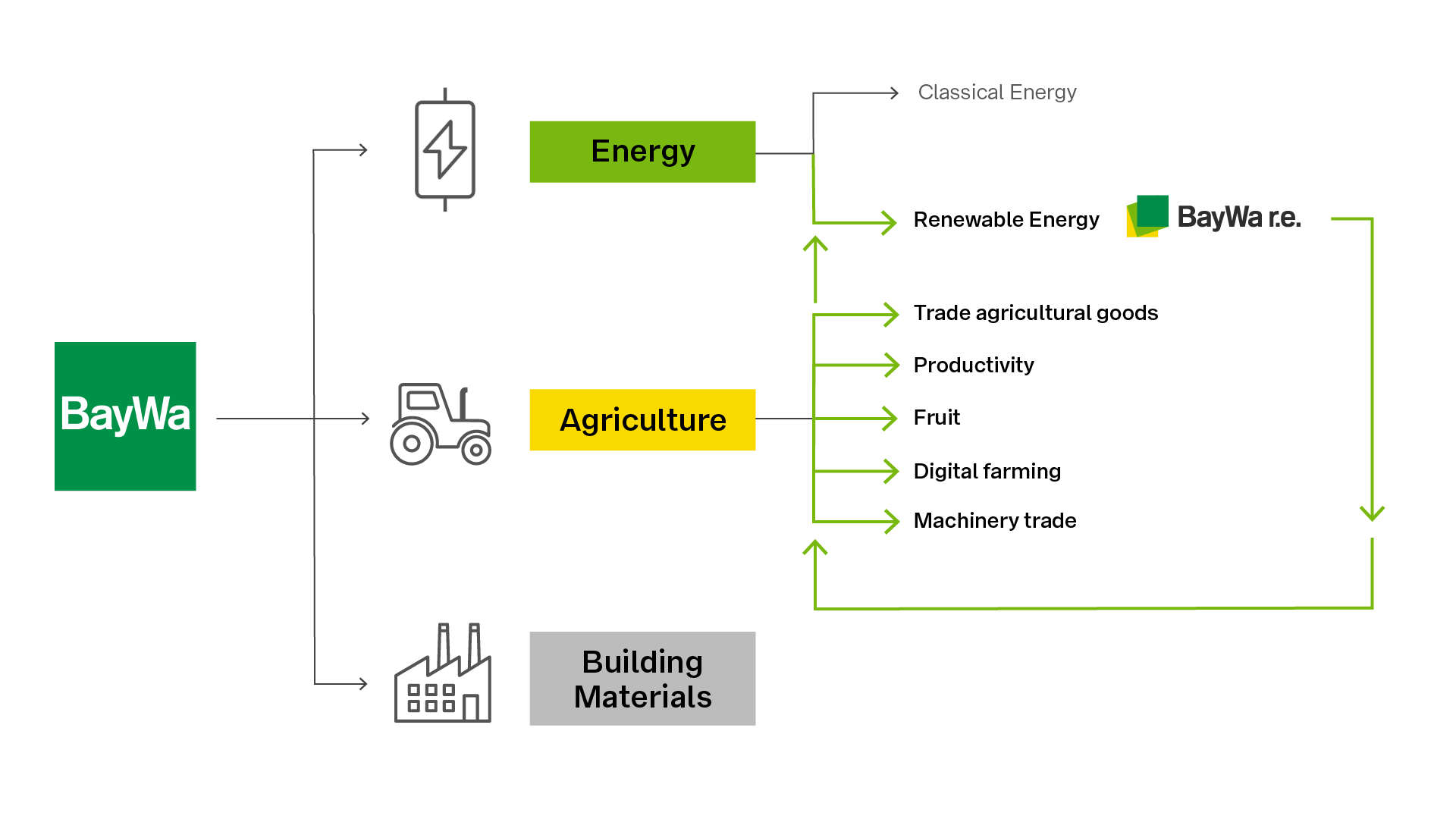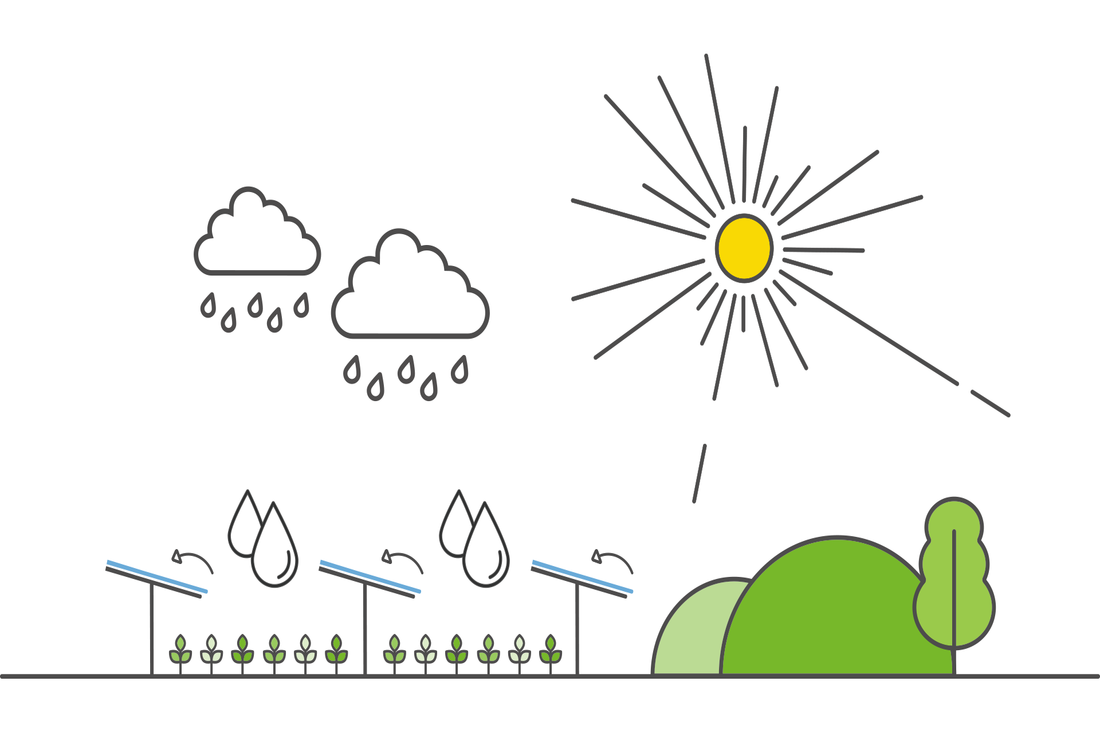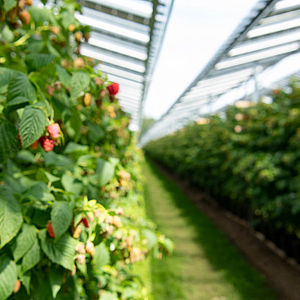Produce sustainable food and solar power on the same land, at the same time
Agri-PV is in our DNA
At BayWa r.e., agriculture is woven into our DNA through our parent company, BayWa AG. Preserving our natural environment and safeguarding soil for food production are especially important to us.
When it comes to agriphotovoltaics (Agri-PV), you’ll benefit from our extensive knowledge and support in everything from plant physiology to operational management of PV systems.
We support you through the entire process including planning, purchasing, financing and turnkey installation.
Our top priority is that every project we implement provides added value and a financial return for you. Whether you need the maximum benefit from your Agri-PV system to use the generated power yourself, or prefer a leasing or licensing model, get in touch with us to discuss your options.
Harvesting the synergies of two sectors with Agri-PV

Our solutions in the field of Agri-PV implementation
Solar Gains for Agriculture
With Agri-PV, your land does two crucial jobs at the same time: firstly, maintaining its original agricultural purpose and secondly, generating clean power. But because farming is so complex, you’ll need an Agri-PV solution that’s adapted to your specific site.
Together, we’ll develop a project that optimizes the techno-ecological and techno-economic potential of your land.
Our mission is to implement the worldwide, almost inexhaustible potential of Agri-PV in a wide variety of application areas in a meaningful and most beneficial way for the farmers. Right now, our focus is on two main applications of Agri-PV: Interspace PV and Overhead PV. With interspace PV, crops grow between large-spaced, ground-level rows of module rows, making room for machinery to pass through. With Overhead PV, crops are cultivated underneath elevated solar modules.
Interspace PV
Global food demand is set to increase 50% by 2050, while a third of farmland is at risk of degradation. It’s never been more important to preserve fertile soils and healthy farmlands for future generations. Interspace PV is an important tool to help you meet that ecological challenge.
Interspace PV cultivates low-growing crops like wheat, legumes or greenland between ground-level module rows, with enough space for land machinery to pass through. Our Interspace PV tracker system design with high-performance, bifacial modules installed on one axis, follows the sun from morning to evening for maximum solar yield throughout the day.
Our Interspace PV fixed tilt system design comes with an ideal inclination according to your country’s latitude and is best suited if your field cultivation is east-west-oriented. It is also preferred to a tracker system when the agricultural field is particularly uneven or on a slope.

Benefits
Overhead PV
Overhead PV uses elevated solar panels installed above growing crops like berries or espalier fruits. While generating solar energy, they also offer shade and protection from your crops against the effects of extreme weather.
These panels are placed high enough for farming operations to continue uninhibited. Growing wires and irrigation systems can be integrated easily and safely into the substructure of the module system.
Even the transparency of the modules themselves can be adapted, letting the ideal amount of light pass through for each crop. The cooling effect of the plant growth allows for better energy yield, because solar panels generate the greatest yield when the incident solar radiation is at a maximum and the ambient temperature is as low as possible. Far from providing an obstruction, Overhead PV can introduce new efficiencies into your day-to-day work.

Benefits
Do you own a suitable piece of land?
We Are Interested in
For Interspace PV, we are looking for high soil quality green land or arable land of minimum 20 hectares with low-growing crops such as wheat or legumes.
For Overhead PV we are looking for land with 3 hectares minimum used for the cultivation of permanent cultures or special crops like fruit. You benefit from lower investment, maintenance and operating costs while reducing the short-lived materials used for crop protection.
At the same time, we are offering you, as a farmer, the opportunity to become a co-investor and therefore co-owner of the Agri-PV system, which will allow you to diversify and stabilize your income through the sale of green electricity.
Our Activities
Project Structure
Project Structure
Operational Management
Operational Management
Plant Physiology
Plant Physiology
Distribution of Fruit Products
Distribution of Fruit Products
Agricultural Machine Technology
Agricultural Machine Technology
Irrigation Systems
Irrigation Systems
Project Development
Project Development
Engineering, Procurement & Construction
Engineering, Procurement & Construction
Learn more about our Agri-PV references here

Austria
A small country with large Agri-PV potential: check out our first Interspace PV and Overhead PV projects from our subsidiary Ecowind.

Germany
While Germany has recently enrolled innovation tenders for Agri-PV in its EEG, we did not miss the chance to become a forerunner with innovative pilot projects.

The Netherlands
The Netherland has been our first active market for Agri-PV. Check out or comprehensive reference list of Agri-PV installations here.

Spain
Check out or first Interspace PV project in Spain, which includes a corporate PPA with offtaker VELUX.
Video Gallery
Frequently asked questions about our Agri-PV solution
- How can farmers benefit from BayWa r.e.’s Agri-PV systems?
Our Agri-PV systems make the best possible use of the synergy between crop production and energy generation. Depending on the application you use, you can feel a range of techno-ecological benefits like protection of crops from hail and excess sunlight and from excess evaporation of water from the plants and soil, reduction of soil erosion due to wind, stabilization of crop production due to micro-climates.
- What are the advantages of a partnership with BayWa r.e.?
The BayWa Group combines agriculture and energy in a unique way. More than 30 years of experience in the field of renewable energy have given us comprehensive expertise in this sector, so we view ourselves as both forerunners and friends of the green energy revolution. Our capacity for innovation, as demonstrated by our floating photovoltaic systems, has already made us a pioneer in the creation of dual land-use solutions. Now, we’re adding to this successful track record with Agri-PV. We are a full-service provider with a solid financial foundation, and we consistently adhere to the highest standards of quality.
Our parent company, BayWa AG, generates annual turnover of approximately 17.2 billion euros and has been doing business in the agricultural sector since 1923. Furthermore, in addition to our support as an expert partner during the planning and realization of the system, we also offer to look after the entire operations and management of the system in the long term.
- Do Agri-PV systems impair the economic viability of agricultural crops?
No, because in the framework of the strategy for the agricultural use of the land, a break-even analysis must be carried out for the crops involved. The profit margins for the agricultural products must be positive. Our top priority: Every project that we implement should provide added value for you as a farmer and generate a financial return.
- Does the way the panels are mounted make it more difficult to work the land?
No. Panels must be installed so that land can still be used as it was previously. Overhead PV modules have to be installed at least 2.1m high, for example.
- How do you ensure the optimal availability and uniformity of light for my crops?
The light intensity or degree of shading and the uniformity of the light, as well as peripheral effects, are examined and configured for the needs of the specific agricultural products. The transparency of the panels that we use is adapted to the particular crop involved.
- With regard to crop changes, what restrictions am I under once the Overhead PV mounting system has been established and the panels have been chosen?
Our specially designed transparent solar panels are ideal for berries like raspberries, currants, blueberries, strawberries and blackberries. The substructure can also be designed in such a way that cultivation in soil is possible, e.g. for perennial raspberries. In the case of cultivation in a substrate, the rotation of crops plays a role with regard to soil exhaustion. The same is true for perennial crops, such as espalier fruit or wine grapes, especially considering that these crops are in place for over 15 years and might then be replanted or grafted.
- Will my crops get enough water underneath an Overhead-PV system?
The availability of water, to the extent influenced by the Agri-PV system, is adapted to the growing conditions of the crop in question. We take care to ensure a uniform distribution of rainwater for the crops beneath the Agri-PV system, and this can be optimized through extra technical equipment. Beneath an Agri-PV system there will also always be some areas that aren’t covered by solar collectors.
- Is soil erosion a problem?
We offer technical solutions to help mitigate the effects of soil erosion and take the agricultural requirements into account. Likewise, collection basins or draining equipment can be used for rainwater. Systems for distributing rainwater can also prevent the formation of icicles in the winter. For Interspace PV, soil erosion can even be reduced due to wind protection from the ground-level module rows.
- Will I lose EU agricultural subsidy when installing Agri-PV on my land?
No. Because the prime purpose of your land is still farming, you still receive EU agricultural subsidies. We are committed to ensuring that the fiscal treatment of the area would remain farmland.














